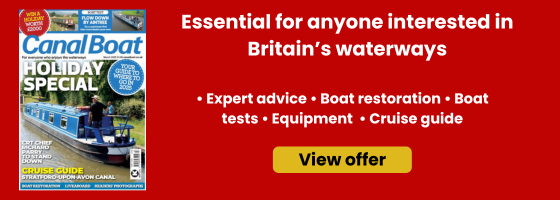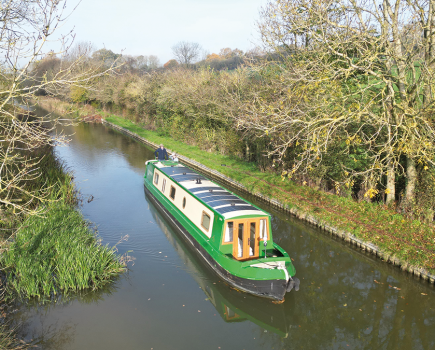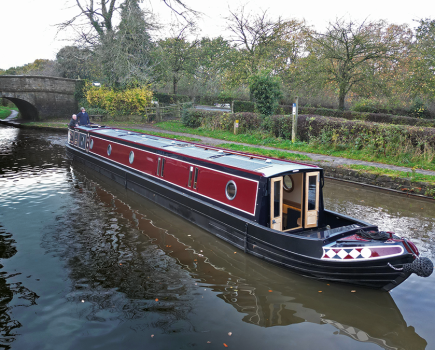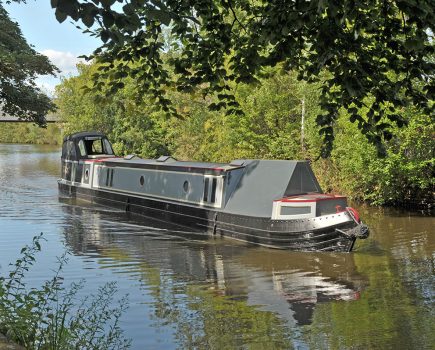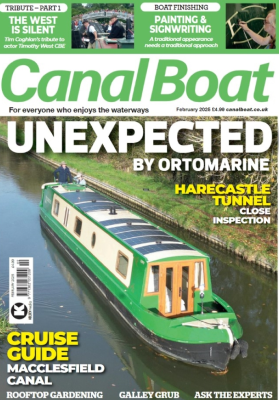Otherton DB Narrowboat
A ‘Dutch Barge narrowboat’ sounds pretty much like a contradiction in terms – after all, Dutch Barges tend to be around 12ft wide and narrowboats aren’t. So such an idea for a boat is an interesting proposition, which is why we were keen to try out Liquorice Fields after looking her over at Crick.Although the DNb idea isn’t new, we liked what we saw and were keen to see how this style of boat with, in this case, its bedroom at the rear and an open-plan living area in the main cabin would stack up. What’s more we wanted to find out what it would be like to live with and on the water. You’ll recognise the name Liquorice Fields from John Betjeman’s poem about love in Pontefract and, as with his poem, it’s certainly a head-turner. In fact, the styling makes the boat appear much larger on the water than the reality of its 57ft length and 6ft 10in beam.So much so, in fact, that when we took it out other boaters found it hard to believe that the boat would fit in the single-width lock a third of a mile down the Staffs & Worcs from Otherton Boat Haven. It did, comfortably. Owners Mike and Kath Allen have just taken it over and are also finding that Liquorice Fields raises keen interest wherever they go. EXTERIORThere’s no question that this is a well proportioned boat that looks right, from the Dutch Barge-style counter along the back cabin, wheelhouse and main cabin to the sharp, almost Titanic-style bow. The cream painted shell is by HT Fabrications in Leicester and uses 10-6-4 steelwork. By the nature of the design, the swims are different to those of a ‘standard’ narrowboat; at the front it runs flat to where it meets the forepeak, while at the rear, the swim is similar to most narrowboats as far as the counterplate where it then sweeps up to give the Dutch Barge-style stern.Along the sides, the gunwale walkway is a couple of inches wider than usual which, together with full-length handrails on the roof, makes moving to the bow relatively easy – and it needs to be because with only an ‘escape’ hatch up front you can’t do the usual slalom through the boat to get onto the front.The roof itself is relatively bare with just a few chrome air vents breaking up the expanse of non-slip cream paintwork; there are no Houdini hatches, pigeon boxes, aerials or any of the other ornaments that often crown the top of a narrowboat.The wheelhouse looks the part with a red canopy and wood-framed windows all around. Although it looks high, Otherton’s Phil Dorrington assured us that the height from the water isn’t actually any more than that of someone of average height standing on the back of a narrowboat, so it should fit under most bridges with the wheelhouse up, although care needs to be taken where bridges arch down to the sides because of the width of the wheelhouse roof. When things do look a little tight, it’s quite simple to take the top off: the canopy unclips, its light support bars lift out of their mountings and the windows hinge down around the sides. We timed the job at around four minutes which isn’t too bad – rather like dropping the top on a Seventies Lotus. Of course much of Mike and Kath’s cruising will be done with the wheelhouse down anyway so it shouldn’t be a problem.DESIGN AND INTERIORThis was very much a clean sheet design because it was the first narrowbeam Dutch Barge fitted out by Phil and Jacqui Dorrington, the owners of Otherton. Mike and Kath decided they wanted their main bedroom in the back cabin, with the main cabin being open-plan with a galley, dinette and saloon, and the shower-room and toilet being tucked away in the bow. The interior is lined with light oak (with the grain running horizontally) trimmed with ash and this, together with the open-plan design, has produced a main cabin that’s light despite the lack of roof openings and feels much larger than it actually is. The light comes from three windows on each side and a pair of side-hatches towards the front.WHEELHOUSEBecause this is a Dutch Barge design, we have to start in the wheelhouse which, as well as being the steering position, is of course a room in its own right. Entry is through a pair of metal doors on either side, and there’s just one step down (which provides useful storage for pins, mallets, oil cans etc) into the interior, which is finished in the same two-pack cream polyurethane paint as the exterior. The wheel is situated in the left front corner with the bow thruster controls, rudder indicator and engine instruments just in front of the helmsman, and a Teleflex throttle on the left-hand wall. To the right, a hatch leads down into the front cabin and a shelf runs across the front which could have been made for mugs of tea… At the rear a centrally positioned hatch leads down into the back cabin and there’s a weather-proof 240v socket tucked down in the left-hand corner.While there’s plenty of room here there’s no fixed seating so at the very least a couple of bar stools would make long cruises more comfortable (a drop-down, side-mounted seat would be great for the person at the wheel) although it’s quite pleasant to lean against the side and watch the world go by. That said, the wheelhouse provides a great social area and much more can be made of it and probably will. When we carried out our test the boat hadn’t been handed over to Mike and Kath so they hadn’t fully furnished it.Because the wheelhouse is inevitably going to get wet inside at times, and the engine hatch is in the floor, there’s a hidden gutter around the engine hatch that takes any water down four tubes and out through the side of the hull – a very good idea. The wheelhouse’s other party trick is blown-air heating, which will be fabulous for winter cruising (it was a popular place at Crick…). BACK CABIN
Two steps take you down into the bedroom which has an almost chapel-like air of calm, due in part to the attractive stained glass (which, appropriately features a liquorice plant) in the rear hatch above the bed that filters coloured light into the space; more light comes from portholes on either side. On the left-hand side of the hatch there’s an en-suite toilet containing a cassette loo, while on the right there’s a full-length wardrobe. The bed is centrally positioned against the rear counter and is a good-sized 4ft x 6ft 2in. There’s useful storage underneath with a central pull-out drawer and cupboards either side, plus there’s more storage either side of the bed in hanging wardrobes. It’s a good-sized, well designed, pleasant space that feels like a ‘proper’ bedroom-cum-sanctuary with stacks of storage; unlike a normal narrowboat, you don’t have to pass though the bedroom on your way somewhere else which gives it a nice feeling of privacy. One of the drawbacks, though, is the fact that the bed is on top of the weed hatch so to check the prop you have to lift the mattress, but there really isn’t any other solution. The stern gland isn’t a problem because it’s water-lubricated. Also, as early morning tea is a vital part of most of our lives, investing in a teasmaid would avoid having to hike up and down into the galley for two steaming mugs of restorative first thing in the morning.
MAIN CABINTwo steps take you down from the wheel-house into the main cabin which appears huge. Mike and Cath liked the open-plan design of Otherton’s showboat at Crick last year and asked for something similar in Liquorice Fields. The first part is given over to the galley; on the right-hand bulkhead are all the electrical switches, fuses and the mains distribution panel above a granite-like worktop which contains cupboards, drawers and a useful wine-rack, while on the left is the business part for cooking. A lot of thought has gone in here to make good use of the space; the Vanette oven has been placed against the rear bulkhead with a microwave above hidden by a wooden flap that drops down, and alongside them are three storage shelves. From there the work surfaces extend forward to include a Vanette four-burner hob and a chrome sink and drainer. In addition to storage in the cupboards underneath, the doors hide a freezer and a fridge. There’s an Indesit washing machine, too, but its depth didn’t quite allow the fitting of a matching door.Forward of a half-bulkhead there’s a four-seater Pullman-style dinette with cherry red cushions that drops down to make a decent double bed for guests. Forward of that, past another half-bulkhead, is the ‘saloon’ part with space for two large cream chairs with footstools, a neat end unit that houses the TV, DVD recorder etc and a glass-fronted top cupboard for ornaments – a nice touch that gives a feeling of homeliness.The whole of the space is light and bright thanks to three large windows down each side and a pair of hatches either side of the saloon area. Light oak panelling with the grain running lengthways and light oak flooring make the cabin seem wide and long and big.This cabin interior might be simple and lack the ‘cleverness’ of some other narrowboat interiors, but this is what Mike and Kath wanted and it’s very effective – it’s unfussy and clean-looking. The cherry colouring of the cushions, blinds and kitchenware and chrome light switches and power points give it an attractive, contemporary feel. If we had one complaint, it would be that the main copper gas pipe runs from the gas locker in the bow under the left-hand gunwale and is quite visible when you are sitting down.BATHROOMForward of the main cabin a sliding door leads into a very spacious, full-width bathroom tucked neatly into the bow. With the design of the boat, this is a good place to site it and it works extremely well. There’s a large, walk-in semi-circular corner shower to the left of the door against the bulkhead, and next to it a wardrobe for guests. Midway towards the bow there’s a Jabsco electric loo and then stretching the width of the front there’s a sink set into a wide vanity unit. This has plenty of storage underneath (it also hides the bow thrusters) and a heated towel rail.Above the sink there’s the forward (escape) hatch which when open, together with frosted portholes on either side, lets in plenty of light. Two doors open outwards and the top metal section swings up and back to rest on the roof.It’s a big, pleasant space for a narrowboat shower-room, trimmed in the same light oak panelling with light grey tiles in the shower and behind the vanity unit; the cherry red colouring from the saloon is carried through in the edging around the tiles. If you’re the type of boater who cherishes a decent bathroom, you’d like it a lot.TECHNICALBecause this is a ‘Dutch Barge narrowboat’ there have been some interesting engineering solutions to power the boat and for the siting of some equipment. The engine hatch in the wheelhouse floor lifts up easily, exposing a large space below for the 42hp Vetus engine but it needs it.Running a propeller shaft underneath the back cabin is pretty much a non-starter given the boat’s shallow draft (it would have cost 15 inches of headroom in the back cabin), so the obvious solution has been to use an hydraulic drive, which means the engine can be in any position. Here it’s been turned around and faces backwards which, while it might look rather odd (and tightening the fan belts looks a little awkward) means that all the hydraulics that usually come off the ‘back’ of the engine are now at the ‘front’ and more readily accessible. The hydraulic set-up doesn’t come cheap at around �11,500, however it does mean you can have hydraulic bow thrusters so there’s a bit of a saving there.Aside from that the engine bay is reasonably standard with the exhaust silencer and batteries on the starboard side and the calorifier to port, together with the water pump and hydraulic reservoir. The forward end of the engine bay, meanwhile, has been given over to the 235-litre diesel and 200-litre water tanks.Twin alternators power the electrics, with a 95amp one for the starter battery and a 150amp unit to charge the five 110aH batteries in the domestic bank. Because this will be a liveaboard it has a Moore Power 2500 inverter and also a 25amp charger that runs off the mains. For heating, there’s a 9.1kw Webasto diesel heater.ON THE WATERFor this particular boat test this is the big one because here it really is different – no tiller and a wheel placed some 17ft forward of the rudder. To turn left or right, you have three turns of the wheel each way and the temptation is to spin the wheel as you would a river of sea cruiser – this doesn’t work… You still need the narrow-boating mindset even though you have a wheel in your hands.So the technique is to use the forepeak as a gunsight and give the wheel one turn in the direction you want to go, then back it off by a quarter of a turn so that it doesn’t swing too fast, and then take the rudder off when you are pointing in the right direction. Obviously, you can crank on more wheel but that should really only be necessary when manoeuvring or for tight turns.Allied to this, you have to think about the fact that being one-third the way along the boat you’re much closer to the pivot point which feels odd, but you soon get used to it. What’s harder to acclimatise to is the lack of feel from the rudder; I like to feel every twitch and vibration through the tiller and you don’t get this through the hydraulics that lead to the wheel, but you do get used to it.It actually takes only an hour or so to get comfortable with the wheel and steering position, and then cruising along the canal seems like a pleasant cross between a cruiser and a narrowboat. The view ahead is pretty much that of a narrowboat and the forepeak ‘gunsight’ is very useful.For this test we were keen to go through a lock to see what differences the boat’s design might show up. Entering is actually easier, but what you really have to be careful of, as with any boat, is the cill. Because you are some 17ft further forward of the rudder than usual, you really have to be aware of what’s going on behind you; the safest best as with any locking is to keep the bow against the gate.CONCLUSIONThe ‘Dutch Barge’-style layout of Liquorice Fields makes an interesting change and in many ways makes more of the boat: the wheelhouse adds an extra dimension, while having a main bedroom in the back cabin provides a separate, private space you don’t always get on other boats. The underlying feeling you get is that this is a big boat, much bigger than the usual narrowboat. For �87,000 with the current fit-out this is a good value boat, and the potential for layout variations is great with sociable cruising guaranteed. For those looking for something different to the traditional narrowboat norm, it must deserve serious consideration.
Length: 57ft 0inBeam: 6ft 10inSteelwork: 10:6:4Engine: Vetus 42hp
Electrical: 12v DC, Moore Power 2.5kw inverter
Otherton Boat Haven
Otherton
Penkridge
Stafford
ST19 5NX
Tel 01785 712515
Price: �87,000 inc VAT including electric bow thrusters www.othertonboathaven.co.uk


